The ASUS X99-E-10G WS Motherboard Review: 10GBase-T Networking with Intel’s X550-AT2
by Ian Cutress on November 7, 2016 9:00 AM EST- Posted in
- Motherboards
- Intel
- Asus
- 10G Ethernet
- X99
- 10GBase-T
- X99-E-10G WS
- X550
- X550-AT2
SLI, SLI, SLI
In our last review of a motherboard capable of 4-way GPU gaming, it was eloquently stated that our failure to test the feature was an indication of AnandTech’s current path on quality. I would have preferred a discourse in actually being able to source four identical GPUs at the time (and then showing ‘wow, it works’ in the review). There are plenty of things we don’t test as rigorously on each product that some users might like, such as PCIe x1 slot bandwidth latency, or USB 2.0 performance on CentOS, either due to time, relevance, or as was the case before, a lack of hardware. This is still the case - I do not have four expensive and high profile GPUs and I live a whole continent and an ocean away from our GPU testing facility. I have procured a third identical GTX 980 however, and will show you that at least 3-way GPU works in our test suite.
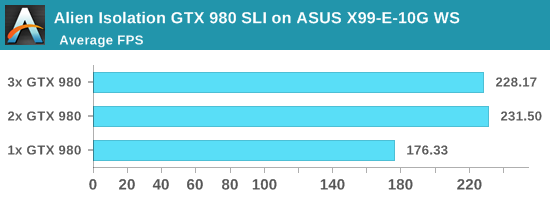
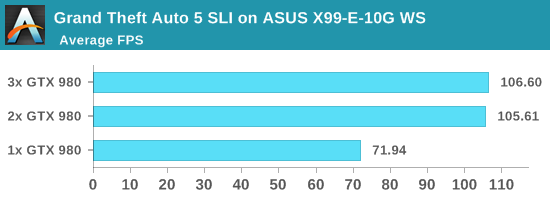
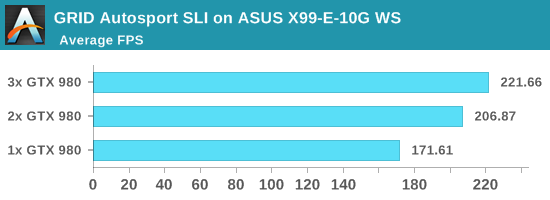
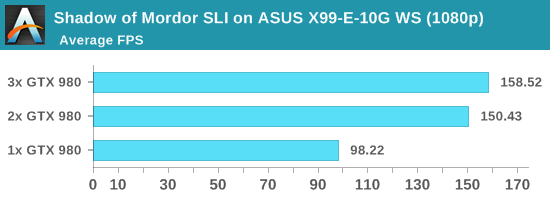
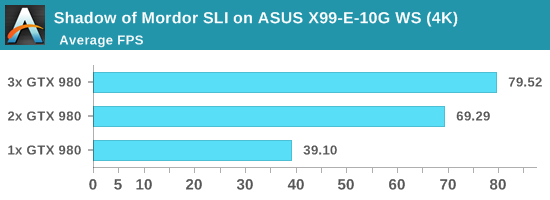
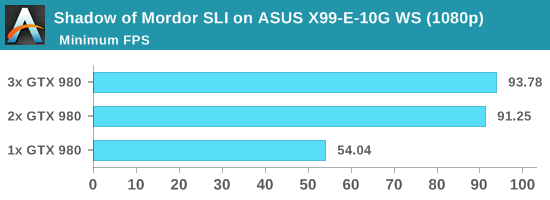
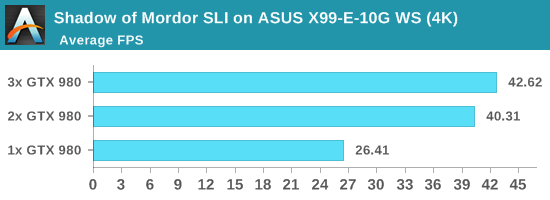
GPU scaling beyond two cards depends on the game engine and the drivers, or if the game has implemented specific multi-GPU modes to accelerate game features. For some titles, the GPU is not the bottleneck, and it might either be CPU performance, PCIe bandwidth, DRAM, or the fact that the game doesn’t scale and we’re relying on the performance of a single card.
Both GTA5 and Alien Isolation scaled to two cards with our hardware setup, but failed to move going to three. GRID is typically a title that scales with almost anything, however the jump from two to three cards was only 7%.
Shadow of Mordor gets the best scaling, but only at 4K and not at 1080p. At 1080p the move from 1 GPU (98 FPS) to 2 GPUs (150 FPS) is significant, but 3 GPUs (158 FPS) is not. For 4K, the scaling keeps going from 1 GPU (39 FPS) to 2 GPUs (69 FPS) and 3 GPUs (80 FPS), although not as much for that last jump. At 4K we are running at our Ultra preset, indicating that some other hard compute part of frame rendering might be the limiting factor in AFR modes.
Testing 10GBase-T and X550-AT2
Similar to our GPU testing, we have not the ideal hardware for Ethernet testing. In our previous 10G motherboard review, we implemented an ESXi 6 platform and used two Windows Server VMs, each with 8 threads, 16GB of DRAM, and one of the 10G ports. As a result each VM had a direct OS-to-OS 10G connection with a custom configured IP and testing was done.
Testing 10G with ESXi was actually more difficult this time around. The X550 series of drivers are not supporting in the default image, requiring the admin to install the relevant plug-in. While this enabled the ports to work in the Windows Server 2016 VMs, ESXi would not allow them under VSXNET mode, which is typically the high-performance mode. I was unable to find a quick solution, and along with the X550 controller being newer, deciphering what needed to be done was also a minefield of frustration.
It is interesting then to note that our results for the ASUS board and X550 are similar to previous results with the ASRock board using X540. This is ultimately because the chips are mostly similar, with the primary difference in the way they communicate with the CPU – the X540 requires PCIe 2.0 x8, while the X550 requires PCIe 3.0 x4. The X550 also introduces some professional level features, but the 10G copper market remains in Intel’s hands without another major player (or that professional environments turn to fiber).
When we last performed this with the ASRock X99 WS-E/10G, and a number of our readers were very helpful in describing ways in which 10G network performance (with the right hardware and knowledge) could be improved. As our test is point-to-point without a managed switch, and the frustrating element of learning to debug the environment, I highly recommend you read the post by Jammrock back in that review. But the 10G ports do both work, I can tell you that.











63 Comments
View All Comments
SnowleopardPC - Sunday, November 27, 2016 - link
The whole 10G Copper is interesting. I have already started wiring my home with Cat 8 1200mhz ethernet cables. I skipped Cat 7 because Cat 7 is running into licensing issues like blu-ray. There are 2 companies fighting over the Cat 7 standard.Cat 8 supports 10G up to 100 meters/300 feet and potentially 25G/40 or 50G at shorter distances.
It is important for me because I am shooting with a Phase One XF and a 100mp digital back for still photography and then Red Dragons at 4 and 6k video resolutions. One of the rooms in the house has been converted to a server room with racks, switches and enterprise grade NAS appliances.
The NAS Supports 40G through 4 10G copper ports,
Hixbot - Monday, November 28, 2016 - link
Would think that fiber with SFP+ equipped gear would be more affordable and easier to work with. I have never worked with CAT8 but my thought is it must be heavy and rigid and terminating those RJ45s to Cat 8 standard must be a chore. I admit my experience in this is limited and perhaps your experience has shown that copper remains the best product for your needs.My experience working in enterprise networking has shown that fiber is the most affordable medium for multi 10G backbones between switch/server rooms, but if you want 10G to the desks/cubicle the options are limited and the market is still pushing copper to the desktop.
Me777 - Monday, May 29, 2017 - link
Compute task? What's a compute task?